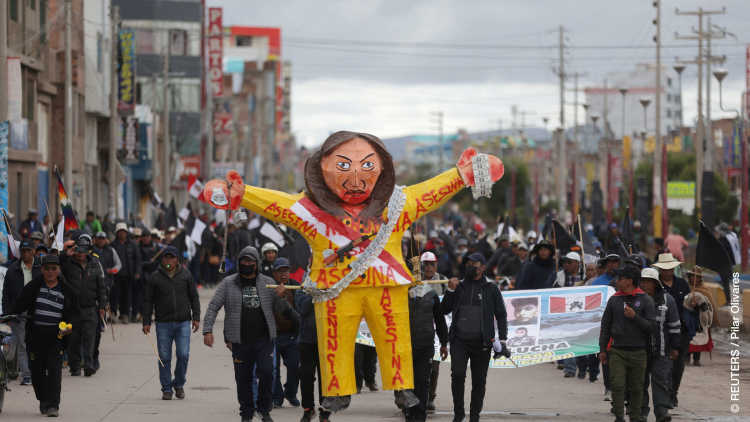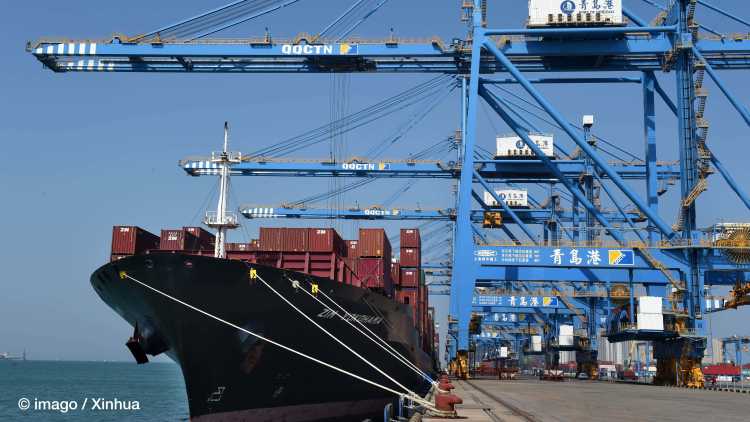- Home
- Publications
- GIGA Focus
- Child Labour Policies in the Americas: Why Progress Has Become Uncertain
GIGA Focus Latin America
Child Labour Policies in the Americas: Why Progress Has Become Uncertain
Number 3 | 2025 | ISSN: 1862-3573

One in 10 children worldwide works, which can harm their well-being and have broader socio-economic consequences. While the ILO advocates for eliminating child labour, strategies across the Americas range from prohibition to legalisation, and everything in between. The US, Brazil, Peru, and Bolivia illustrate how competing interests shape child labour policies, leading to contrasting outcomes.
Traditionally, the Global North has been at the forefront of initiatives to combat child labour. However, several US states have recently taken steps to weaken child labour laws, a move supported by Republicans and business groups, making it easier to employ minors in (hazardous) work.
Brazil and Peru stand out in addressing child labour through strict prohibitions. While Brazil complements its restrictive child labour policies with extensive social programmes, Peru does not.
Bolivia adopted permissive child labour policies, driven by the lobbying of working children’s organisations, which advocate for the protection of working children and adolescents. In Peru, these organisations have had less influence over the years, resulting in a more restrictive approach. Nonetheless, both countries continue to struggle with child labour due to the absence of complementary social strategies.
Policy Implications
In poor countries, restrictive child labour policies are unlikely to work without social strategies. In their absence, permissive policies that provide meaningful regulation may offer a safer option for minors working out of financial need. International actors should support the expansion of cash transfers and the formal inclusion of representatives of affected populations in policymaking.
Contested Approaches to Child Labour: From Prohibition to Regulation to Legalisation
Since the 1970s, the International Labour Organization (ILO) has set the international norm to eradicate children’s work below the minimum age of 15 years (14 for developing countries) and prohibit adolescents’ engagement in hazardous work through Conventions 138 on the Minimum Age and 182 on the Worst Forms of Child Labour. Given these standards, one would expect universal consensus on child labour eradication or consider it a resolved matter. Yet, countries worldwide differ in their approach towards child labour, ranging from prohibition to regulation to legalisation.
Brazil’s Constitution explicitly prohibits child labour and sets the minimum working age to 16. Argentina included child labour in its penal code in 2013, making it the only country in Latin America to allow imprisonment as a punishment for employing children. Other countries take a more permissive approach: In Guatemala and Honduras, children can receive work authorisations when justified by their socio-economic circumstances, even when they are younger than their countries’ respective minimum working ages (14 for Guatemala and 16 for Honduras). In 2014 Bolivia legalised work for children 10 and older with protections – a decision which was later reversed (in 2018). This permissive approach is not restricted to poorer countries: US federal law permits children as young as 10 to work in non-hazardous agricultural activity and allows those aged 16 and 17 to perform agricultural work classified as hazardous.
Figure 1. Child Labour in the Americas (in %) (hover over each flag to see more information)
Source: UNICEF.
What explains these differences? The role of different actors shows how contentious the topic of child labour is and how it is shaped by (dis)agreements over values, children’s rights, and economic interests. In the US and Brazil, conservative right-wing politicians backed by business and agricultural interests seek to facilitate children’s access to work, including hazardous work. In Bolivia and Peru, on the contrary, it has been completely different actors that have lobbied for permissive policies: working children’s organisations who emphasise that only legalisation and regulation can ensure good working conditions. Bolivia’s respective organisation has been remarkably successful, while Peru’s has seen its influence decline as its ties to the state have weakened. Peru’s executive branch and civil society support the ILO approach, seeking a more restrictive policy. Yet both Bolivia and Peru continue to struggle with high child labour rates, indicating the difficulty of addressing child labour when it is not flanked by a comprehensive strategy of social policies.
Figure 2. Restrictive to Permissive: Child Labour Laws in Peru, Bolivia, Brazil, and the United States (hover over each flag to see more information)
1: Although this loophole would allow night work for those 15–18-year-olds, the complexity of the conditions imposed are stringent enough to classify the regulation itself as restrictive.
I exclude loopholes referring to apprenticeships and artistic activities.
* Conservative right-wing politicians in Brazil have introduced bills to decrease the minimum working age to 14 years. ** Peruvian politicians have sought to reform the Children Code, which includes an increase of the minimum working age to 15 years and eliminates the loophole on light work. The proposal was archived in 2021. In 2023, a bill was proposed in Congress that creates again the Special Committee for the Revision of the Code for Children and Adolescents. The National Committee to Eradicate Child Labour continues to push for an increase of the minimum working age.
Sources: Unless otherwise specified (e.g. by the years indicated), the table is based on the most recent legal frameworks on child labour, including the Constitution, the Children’s Code, the Labour Code, relevant decrees, public policies on child labour, and proposed amendments to these documents.
The United States: Conservative Push Weakens Child Labour Laws
The US is making headlines as several states are dismantling child labour laws. Between 2021 and 2024, at least 15 states introduced bills to lift restrictions, with some succeeding. These changes eliminate the need for work permits (e.g. Alabama, Arkansas), increase the permitted number of work hours (e.g. Iowa, Ohio, Wisconsin), and facilitate children’s entrance into hazardous work (e.g. Florida, West Virginia, Minnesota) (Mast 2024; Sherer and Mast 2023). Proponents are mainly Republicans backed by business groups. The National Federation of Independent Business, which has a reputation of supporting a right-wing agenda (Sherer and Mast 2023), particularly stands out here. Proponents claim that labour shortages justify children’s work – an argument now linked to the reduction of immigrant workers caused by Trump’s deportation policies (Valinsky 2025). Lifting restrictions benefits business interests, as they would avoid fines and penalties while benefitting from cheap and exploitative labour. The weakening of child labour laws has coincided with an upsurge in child labour violations, with the United States Department of Labor (USDOL) reporting a 37 per cent increase between 2021 and 2022, and a 283 per cent increase between 2015 and 2022 (Sherer and Mast 2023).
This marks an important shift for the US, which has historically pushed for child labour abolition in its foreign policy. Alongside the ILO, the US became one of the main actors to push for the elimination of child labour, especially during the increase of international trade in the 1990s. In 2009 the US notably spent more than USD 26 million on fighting child labour worldwide, exceeding the financial contributions of all other countries combined, according to Human Rights Watch (HRW 2010). The US also turned to more coercive measures to the point of threatening countries who did not comply with their child labour standards, for instance threatening to withdraw trade privileges from Bolivia when the latter lowered the minimum working age to 10 years in 2014.
Yet, the US remains one of the few countries that has not ratified Convention 138, which sets the minimum working age at 15, but only Convention 182, which protects children against hazardous work. Moreover, US domestic policies do not reflect the same abolitionist approach. Within the US, child labour standards are relatively lenient, especially in agriculture. In 1938 the Fair Labor Standards Act (FLSA) was drafted, regulating the work of minors. Initially, it excluded the regulation of children’s agricultural work, as family farms were widespread. Only in 1974 did the FLSA add restrictions on agricultural work (HRW 2010). According to current regulations, the minimum age for employment is 16. However, loopholes allow children aged 14 – and, in certain cases, even those younger than 14 – to work in non-hazardous activities. In agriculture, children as young as 10 can work in non-hazardous agricultural activities, while those aged 16 may perform work classified as hazardous. Regulations also allow children from the age of 12 to work on tobacco farms.
Since at least 2001, members of the US Congress have repeatedly introduced the so-called Children’s Act for Responsible Employment (CARE Act) to align the minimum ages of agricultural and non-agricultural work. During the Obama administration, Democrats also tried to ban the work of children on tobacco farms. Yet, these proposals were successfully opposed by farmers and Republicans, who claimed they would threaten family traditions and practices.
Nevertheless, while six states weakened legislation in 2024, seven strengthened it, particularly in terms of increasing penalties and restricting work hours (Mast 2024). Finally, in early 2024 the Democrats introduced the CARE bill into the Senate, which is meant to close the loopholes in the working age. This bill also considers farmers’ demands by not including children who work on their parents’ farms (Maki 2024).
The CARE bill is currently pending. Yet, doubts about its potential impact remain, as families would continue to depend on the financial support of their children due to low wages and limited access to childcare (Hsu 2023). In addition, although federal laws override state laws when the latter are too permissive, the recent lifting of restrictions at the state level can have important consequences on the federal level as well. Indeed, the aim of these state-level changes seems to be slowly pushing for more permissive child labour policies on the federal level (Sherer and Mast 2023).
Finally, Trump’s second administration does not provide any hope on that matter. Project 2025 – an extremist, right-wing policy agenda laid out for the present and future Republican presidency – includes the goal of making dangerous work more accessible to adolescents. Moreover, since returning to power, Trump has already made cuts to approximately 70 international programmes aimed at combating child labour, forced labour, and human trafficking. It is not only Trump’s push against all kinds of regulations on businesses that target child labour rules, but also his aggressively anti-immigrant agenda, which is likely to further worsen conditions for children. Immigrant children are unlikely to report abuse due to increasing fear of deportation (Wurth 2025).
Brazil: Restrictive Policies and Social Protection Efforts under Pressure
Brazil has been a pioneer in restricting child labour. Importantly, this has been accompanied by a social strategy. Brazil’s Constitution prohibits children under 16 from working; this modification was made even before the country ratified ILO conventions 182 and 138 in 2000 and 2001, respectively. Between 1992 and 2008, Brazil drastically reduced children’s work among those aged between 7 and 15 years from 18 per cent to 7 per cent (ILO, UNICEF, and the World Bank Group 2011). More recently, the Brazilian Institute of Geography and Statistics reported that the percentage of children and adolescents (aged 5–17) engaged in labour stood at approximately 4.2 per cent as of 2023 (IBGE 2024).
Brazil’s story shows the importance of coupling child labour laws with social policy expansion. The country managed to lower poverty as well as improve access to education and basic services while at the same time increasing the minimum working age, which has produced positive outcomes. Especially important in addressing poverty – and thus indirectly child labour – have been the cash transfer programmes. One of these, the Child Labour Eradication Programme (PETI) even addresses the issue directly by providing cash transfers to families with working children. Initially focused on children in hazardous work, PETI eventually broadened its scope to child labour in general. To receive the grant, children must comply with a minimum school attendance and after-school activities – and must not work. Their parents are also afforded the opportunity to participate in programmes which help them to increase their household income (ILO, UNICEF, and the World Bank Group 2011).
PETI was created in 1996, and in 2005 the programme was integrated into the Bolsa Família programme – Latin America’s (and arguably the world’s) largest cash transfer programme to support families in poverty. Bolsa Família unified already existing programmes focused on families with children and adolescents living in (extreme) poverty: Bolsa Escola supported access to education, Bolsa Alimentação and Carta Alimentação aimed to improve nutrition, Auxilio-Gas supported the purchase of cooking gas, and PETI focused on getting minors out of (hazardous) work activities. In 2011 PETI was further integrated into the National Social Assistance Policy, officially becoming part of Brazil’s national social assistance strategy. Brazil particularly stands out due to the extensive reach among families in poverty: in 2023 Bolsa Família covered 35.6 per cent of children aged 5–17, and in 2025 approximately 92 per cent of people in the poorest income quintile (IBGE 2024; CECAD 2.0 n.d.).
Yet, similar to the US, in Brazil there have also been efforts to weaken restrictions on child labour. Politicians from right-wing parties have introduced several proposals in Congress to reduce the minimum working age from 16 to 14 years. Proponents claim that the reduction of the minimum age is in the interest of the child as it would regulate children’s informal work and help them escape poverty (Borges 2024). Despite this line of reasoning, in fact it is the sugar cane industry that is the driving force behind such proposals, as it would benefit most from the proposed bill (Vilan 2018). The original proposal PEC18/2011 was introduced in 2011 by a right-wing congressman (and member of the parliamentary caucus representing rural landowners) from Paraná – an important sugar-cane-producing state where child labour is prevalent (Vilan 2018).
In 2021 Bolsonaro’s government tried to push that plan forward, but the proposal and others like it have been stalled for over a decade. Throughout the years, particularly Brazil’s main trade union federation CUT, the National Forum for the Prevention and Eradication of Child Labour, and the Ministry of Labour have voiced their opposition to any weakening of the child labour regulations. In 2024 the proposal was sent to be voted on in the Committee on the Constitution, Justice and Citizenship, where it was rejected on the grounds of unconstitutionality. As of now, the proposal remains on hold within the committee.
Peru and Bolivia: Working Children Organisations Seek “Dignified Work”
Bolivia and Peru are among the Latin American countries with the highest rates of child labour, with both reporting that approximately 12 per cent of children aged 5 to 17 are engaged in such activities. In both Bolivia and Peru, working children’s organisations actively lobby for their rights, aiming to recognise rather than eradicate children’s work. Yet, policies have evolved differently. Whereas Peru seeks to further restrict child labour, Bolivia has pursued a permissive approach, facilitating children’s work under protective rules. Peru and Bolivia both continue to struggle with child labour as they lack social strategies to address its drivers.
Before the ratifications of the ILO conventions in 2002, Peru had been one of the most permissive countries in Latin America vis-à-vis child labour. While most of the region’s countries, including Bolivia, had a minimum working age of 14, Peru’s 1992 Children’s Code set it at only 12 years, due to pressure from the working children’s organisation.
In fact, the first working children’s organisation worldwide – MANTHOC – was founded in Peru in 1976. The movement spread first within Latin America and then throughout Asia and Africa. In the style of trade unions, these organisations bring together and represent working children and adolescents. Their central goal is “dignified work,” meaning that their work should be recognised and their protection ensured instead of being outlawed or otherwise eradicated. These organisations criticise minimum-age restrictions but in general do support a ban on exploitative and hazardous work. They also call for children’s active participation in policymaking related to their rights, including child labour laws.
In 2005 the new government of Evo Morales marked a radical change in politics in Bolivia, engendering stronger involvement on the part of civil society, better indigenous representation, and a shift towards anti-neoliberal economic policies. These policy changes included the new Constitution in 2009 and the new Children’s Code in 2014. The working children’s organisation UNATSBO, created in the early 2000s, through its mobilisation was able to divide opinions on the child labour issue both during the Constituent Assembly and the drafting of the Children’s Code. Its influence led to the omission of child labour eradication from the Constitution and to the Children’s Code lowering the minimum working age to 10 years, among other changes. It was only when the US threatened Bolivia with trade consequences in 2018 that the minimum age was raised to 14 years, without the working children’s organisation being consulted.
In the meantime, in 2011 President Ollanta Humala of Peru brought the issue of child labour onto the political agenda in his country as it ambitiously aimed to fully eliminate child labour by 2021. This opened the door for greater involvement from the ILO and the United States, with the latter supporting Peru financially, especially to provide funds for the National Strategy for the Prevention and Eradication of Child Labour (ENPETI) from 2012 to 2021.
In Peru and Bolivia, working children’s organisations are not formal members of the respective national committees on child labour, though in Bolivia they have begun to participate through the support of the Ombudsman’s Office. Notably, in the Bolivian region of Potosí, the local working children’s organisation is an official member of the local Committee on Child Labour. Peru’s organisation actively sought political involvement and was consulted during the drafting of both the ENPETI and the hazardous work list from 2022, yet its proposals were ultimately disregarded. Today, the Peruvian organisation is cautious about participating in large protests due to increased repression – particularly following the death of one of its members during the 2022–2023 protests against the current government.
Both Peru and Bolivia also stand out in Latin America for their high levels of informality in the labour sector in general. The work of children and adolescents often takes place in the informal sector, and adolescents cannot easily receive a work permit. In Bolivia, between 2019 and 2020, of an estimated 321,000 working adolescents only 133 (or 0.04 per cent) were registered workers (Defensoría del Pueblo 2021). In Peru the situation was similar, as between 2012 and 2019 only 0.2 per cent of working adolescents had a work permit (Egúsquiza Palacin and Félix Córdova 2021).
Yet, Peruvian politicians seek to further raise the minimum age. Proposals have been introduced in Congress since 2011 to modify the Children’s Code accordingly, raising the minimum age to 15 years and eliminating the current loophole which allows children to do light work from the age of 12. Although these proposals have not been successful, Peru’s National Committee to Eradicate Child Labour (CPETI) – consisting of representatives from government and civil society – continues to advocate for such a raise. Bolivia, on the other hand, is not currently discussing an age increase. Government officials view it as unrealistic and fear that the working children’s organisation would mobilise again if such an increase were to be discussed.
While Brazil stands out for its social strategy, Peru and Bolivia have lagged behind. Peru’s main cash transfer programme targeting vulnerable children and adolescents is the National Programme of Direct Help for the Poorest (JUNTOS), which as of 2020 covered only 15 per cent of children – one of the lowest coverage rates among ten Latin American countries examined by one study (Blofield, Giambruno, and Pribble 2021). In addition, JUNTOS reached only around 23 per cent of people of the poorest income quintile in 2019, according to World Bank and ECLAC data. In Bolivia, coverage is higher as the Juancito Pinto transfer programme targets all public primary school children. However, the amount is minimal, accounting for only 2 per cent of the extreme poverty level in the country and thus not providing a meaningful shield against the need to work (Blofield, Giambruno, and Pribble 2021).
Bolivia and Peru do not directly address child labour in their cash programmes and are not planning to do so anytime soon. In Bolivia, government officials claim that it could encourage families to send their children to work in order to qualify for the programme. In Peru, although civil society groups have voiced their support for the inclusion of a child labour indicator, government actors consider its integration into JUNTOS to be too complex.
A Comprehensive Approach to Address Children’s Work
Restrictive policies alone are not likely to be successful in addressing child labour unless they go hand in hand with a comprehensive social strategy. Only then will families have alternatives to relying on their children for additional income. In poor countries where such alternatives are limited or insufficient – such as in Bolivia and Peru – permissive policies could provide an alternative solution, such as including exceptions for families facing economic hardship. This is not the case for the US – a wealthy country – which is purposely dismantling immigration policies and restrictions on child labour, driven by business and political interests instead of a commitment to children’s welfare.
International actors and policymakers should encourage countries such as Peru and Bolivia to indirectly address child labour by improving their existing cash transfer programmes – by increasing both the amount of money and the reach of such programmes. Both countries could also follow in the footsteps of Brazil’s PETI programme as it was initially conceived, directly addressing families with children engaged in hazardous work activities, which civil society actors in Peru demand and is also likely to be supported by working children’s organisations.
In recent years, Bolivia has made important progress in expanding universal social protections in general. Regarding child labour, the Children’s Code includes a social protection programme for working children under 14 and their families. The programme focuses on household income improvement and providing access to essential services. Yet, so far, this programme has not been implemented, and the working children’s organisations have heavily criticised it as unrealistic.
As the four cases have shown, different actors – most prominently, working children’s organisations and business groups – advocate for permissive child labour policies. Yet, their intentions and goals are completely different. While working children seek additional protection and better work conditions, business interests seek cheap and exploitable labour. Working children and their advocate organisations therefore need to be actively involved in the design and implementation of the regulations of child labour to make sure that the protection of children is the priority. The exclusion of these organisations can facilitate other actors speaking on their behalf and shape policies in ways that can harm them. Also in the US, the creation of youth unions has been recommended as a way to improve labour rights for young workers and immigrants (Sherer and Mast 2023).
Footnotes
References
Blofield, Merike, Cecilia Giambruno, and Jennifer Pribble (2021), Breadth and Sufficiency of Cash Transfer Responses in Ten Latin American Countries during the First 12 Months of the COVID-19 Pandemic, CEQ Working Paper 114, Tulane University, Department of Economics.
Borges, Rebeca (2024), Parada há 13 anos, PEC que autoriza trabalho para adolescentes volta à pauta da CCJ, CNN Brasil, 17 June, accessed 22 April 2025.
CECAD 2.0 (n.d.), Tabulador do Cadastro Único, accessed 22 April 2025.
Defensoría del Pueblo (2021), Trabajo infantil y adolescente en Bolivia: Vulneración del Derecho a la Protección de niñas, niños y adolescentes con relación al trabajo, accessed 22 April 2025.
Egúsquiza Palacin, Beatty, and Fernando Segundo Félix Córdova (2021), El trabajo infantil en el Perú: pasado reciente y perspectivas, in: Revista Laborem, 24, 161–188.
Hsu, Andrea (2023), Children as Young as 12 Work Legally on Farms, Despite Years of Efforts to Change Law, 12 June, npr, accessed 22 April 2025.
HRW (Human Rights Watch) (2010), Fields of Peril – Child Labor in US Agriculture, 5 May, accessed 22 April 2025.
IBGE (2024), Trabalho de crianças e adolescentes de 5 a 17 anos de idade 2023- PNAD Contínua, accessed 22 April 2025.
ILO, UNICEF, and the World Bank Group (2011), Understanding the Brazilian Success in Reducing Child Labour: Empirical Evidence and Policy Lessons, Understanding Children’s Work Programme Working Paper Series, June, accessed 22 April 2025.
Maki, Reid (2024), Child Labor Coalition Welcomes the Senate Introduction of the Children’s Act for Responsible Employment and Farm Safety Act of 2024 (CARE Act), Child Labor Coalition, 25 March, accessed 22 April 2025.
Mast, Nina (2024), More States have Strengthened Child Labor Laws than Weakened them in 2024, Economic Policy Institute, 12 June, accessed 22 April 2025.
Sherer, Jennifer, and Nina Mast (2023), Child Labor Laws Are under Attack in States Across the Country, Economic Policy Institute, 14 March, accessed 22 April 2025.
Valinsky, Jordan (2025), Florida Debates Lifting Some Child Labor Laws to Fill Jobs Vacated by Undocumented Immigrants, CNN, 25 March, accessed 22 April 2025.
Vilan, Andrea (2018), The Domestic Incorporation of Human Rights Treaties, UCLA, accessed 22 April 2025.
Wurth, Margaret (2025), New US Labor Secretary, Congress Should Act on Child Labor, Human Rights Watch, accessed 22 April 2025.
Editor GIGA Focus Latin America
Editorial Department GIGA Focus Latin America
Regional Institutes
Research Programmes
How to cite this article
Pieper, Johanna (2025), Child Labour Policies in the Americas: Why Progress Has Become Uncertain, GIGA Focus Latin America, 3, Hamburg, https://doi.org/10.57671/gfla-25032
Imprint
The GIGA Focus is an Open Access publication and can be read on the Internet and downloaded free of charge at www.giga-hamburg.de/en/publications/giga-focus. According to the conditions of the Creative-Commons license Attribution-No Derivative Works 3.0, this publication may be freely duplicated, circulated, and made accessible to the public. The particular conditions include the correct indication of the initial publication as GIGA Focus and no changes in or abbreviation of texts.
The German Institute for Global and Area Studies (GIGA) – Leibniz-Institut für Globale und Regionale Studien in Hamburg publishes the Focus series on Africa, Asia, Latin America, the Middle East and global issues. The GIGA Focus is edited and published by the GIGA. The views and opinions expressed are solely those of the authors and do not necessarily reflect those of the institute. Authors alone are responsible for the content of their articles. GIGA and the authors cannot be held liable for any errors and omissions, or for any consequences arising from the use of the information provided.











